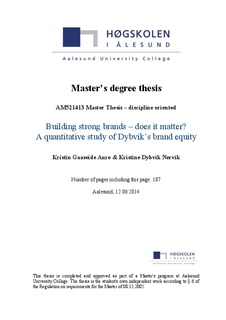| dc.description.abstract | Brand equity has proven, through several decades of research, to be a primary source of
competitive advantage and future earnings (Yoo & Donthu, 2001). Building strong brands has
therefore become a priority for many organizations, with the presumption that building strong
brands yields these advantages (Yasin et al., 2007). A quantitative survey was conducted at
Sunnmøre in Norway in order to answer the two developed research questions.
- Does the brand equity dimensions; brand associations, brand awareness, perceived
quality and brand loyalty, have a significant positive effect on the brand equity for the
brand Dybvik, and does brand equity have a significant positive effect on price
premium?
- Does country-of-origin image have a significant positive effect on the brand equity
dimensions for the brand Dybvik?
The first research question (research model 1) builds on Aaker’s (1991) brand equity model,
where he argues that brand associations, brand awareness, perceived quality, and brand
loyalty have a significant positive effect on based brand equity. In addition to investigate
Aaker’s (1991) conceptual framework of brand equity, the relationship between brand equity
and price premium were investigated, as brand associations, brand awareness, perceived
quality and brand loyalty all have the potential to provide a brand with a price premium
(Aaker, 1991). The sample was split based on whether the respondents had tasted Dybvik clip
fish previously (group 0), or if they had not, or did not know if they have tasted Dybvik clip
fish previously (group 1). The results indicated, that for group 0, brand loyalty and brand
associations had a significant positive effect on brand equity, and for group 1, only brand
loyalty had a significant positive effect on brand equity. In addition, results showed a
significant positive relationship between brand equity and price premium, indicating that
when brand equity increases, so does the willingness to pay a price premium.
The second research question (research model 2) aims to explore the relationship between
country-of-origin image and brand equity dimensions to extend existing brand equity research
(e.g. Aaker, 1991; Keller, 1993; Yoo & Donthu, 2001). Results showed significant positive
relationships between country-of-origin image and the brand equity dimensions included in
this thesis (brand associations, brand awareness, perceived quality and brand loyalty) for
group 0, whereas for group 1, country-of-origin image was found to have a significant
positive effect on brand associations, brand awareness and perceived quality. | nb_NO |

